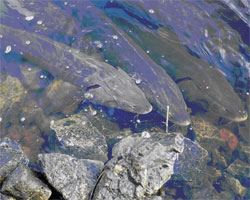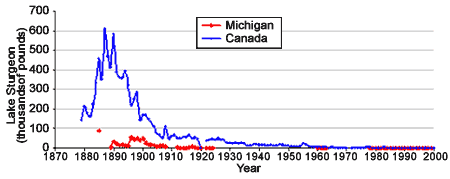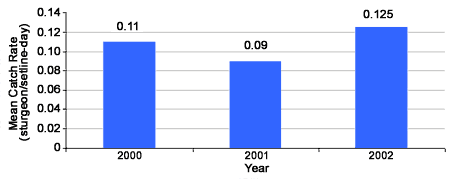Detroit River-Western Lake Erie Basin Indicator Project
Lake Sturgeon Population
Background
The lake sturgeon (Figure 1), a remnant of the dinosaur age, is considered a species of special concern by the U.S. Fish and Wildlife Service, a threatened species in North America by the American Fisheries Society, a globally rare species by the Nature Conservancy, and a threatened species in the State of Michigan. The lake sturgeon population in Michigan is estimated to be about one percent of its former abundance (Tody 1974; Michigan Sea Grant 2005). The Huron-Erie corridor was, at one time, one of the most productive waters for lake sturgeon in North America.

Figure 1. Lake sturgeon (Acipenser fulvescens) (Photo Credit: U.S. Fish and Wildlife Service)
In Lake Erie in the 1800s, sturgeon frequently caused heavy damage to fishing gear in nearshore waters. As a result, they were perceived as a nuisance and frequently killed upon capture to eradicate them (Hartman 1973). In Lake Erie in the 1860s, lake sturgeon were destroyed in large numbers as bycatch of the gill net fishery (Regier and Hartman 1973). Years following, the value of sturgeon increased as their eggs and smoked flesh became a delicacy. In 1890, a "caviar factory" was located in Algonac, Michigan on the St. Clair River (Harkness and Dymond 1961). Populations quickly plummeted due to over harvesting, limited reproduction, and destruction of spawning habitats. Female lake sturgeon do not reproduce until they are approximately 20 years old and even then they only spawn once every few years. Spawning sites also disappeared due to extensive dredging to create and maintain shipping channels in the Huron-Erie corridor. For example, the construction of the Livingstone Channel (1907-1916) greatly decreased lake sturgeon and lake whitefish spawning habitats in Canadian waters, southeast of Stony Island.
Lake sturgeon are an indicator of ecosystem health because they are very sensitive to human disturbances, such as habitat destruction and pollution, as shown by their sharp decline in the late 1800s and early 1900s. They were present in the Huron-Erie corridor before European settlers inhabited the area. Lake sturgeon are considered a keystone species in the Detroit River ecosystem.
Status and Trends
In 1880, Lakes Huron and St. Clair produced over four million pounds of lake sturgeon (Hay-Chmielewski & Whelan 1997). In 1890, Lake Erie produced over six hundred thousand pounds of lake sturgeon in Canadian waters. During the spawning period in June 1890, upwards of 4,000 adult lake sturgeon were caught in Lake St. Clair and the Detroit River on setlines and in pond-nets (Post 1890; Harkness & Dymond 1961; Figure 2). Today, there is no active commercial fishery for lake sturgeon in the Huron-Erie corridor, sport fishing harvest is now restricted in the St. Clair River and Lake St. Clair, and no sturgeon may be possessed by anglers from Michigan or Ontario waters of the Detroit River (Great Lakes Fishery Commission 2003; Michigan Department of Natural Resources 2005; Ontario Ministry of Natural Resources 2005).

Figure 2. Lake Erie commercial fish catch in Michigan and Ontario waters, 1879-2000. The Canadian catch peaked in 1887 at 610 thousand pounds, declining steeply until 1920 when commercial fishing of sturgeon was prohibited in Canadian waters. The Michigan catch was consistently lower than Canada's, its commercial fishery was closed in 1929. (data source: U.S. Fisheries Commission Report - Fishing industry for the Great Lakes Appendix 11 to the 1926 report by W. Koelz and in Baldwin et al. 2002.)
From 1970s to 1999 no lake sturgeon spawning was reported in the Detroit River which, at one time, was one of the most productive sturgeon spawning grounds in the United States. In 2001, however, lake sturgeon spawning was documented on a cinder pile near Zug Island in the Detroit River for the first time in over 20 years (Caswell et al. 2004).
In response to the discovery of sturgeon spawning, scientists conducted research to determine the extent of the sturgeon population in the Detroit River including possible spawning locations and success rates. From 2000 to 2002, they fished with set-lines for 741 days total, while the river was ice free, and only caught 85 lake sturgeon. If this same experiment were conducted in the late 1800s likely over 1,000 lake sturgeon would have been captured. Relative to historical catch rates, the catch per unit of effort during 2000-2002 was low (Figure 3).

Figure 3. Figure 3. Lake sturgeon mean catch rate (sturgeon/setline-day) on the Detroit River in U.S. and Canada waters, 2000-2002.
year 2000: 0.11
year 2001: 0.09
year 2002: 0.125.
(data collected in 2000 and 2001 by Nathan Caswell with Central Michigan University (Caswell 2003), in 2002 by James Boase with the U.S. Fish and Wildlife Service.)
Management Next Steps
Restoration of lake sturgeon in Michigan waters is the primary goal of a lake sturgeon rehabilitation strategy developed by Hay-Chmielewski and Whelan (1997) with the Michigan Department of Natural Resources. In that strategy, sub-goal one recommends "for existing populations [of lake sturgeon] that have less than 100 adult breeding fish, raise populations to that level within 20 years, to maintain genetic integrity..." and "...if a population has 500 or more breeding adults, a harvestable fishery may be considered." For a basin of the Great Lakes, the age structure of a restored lake sturgeon population would include a gradient of year-classes with 10 to 15 percent of those being mature fish and three percent of those being 40 years or older (Holey et al. 2000). Recommended actions include:
- enforcing conservative sturgeon harvest regulations throughout the Huron-Erie corridor; enhancing and protecting sturgeon habitat in the Detroit River (sturgeon habitat has been constructed off Belle Isle in Detroit, McKee Park in Windsor, and Fort Malden in Amhurstburg);
- controlling pollution from combined sewer overflows and other sources within the watershed;
- undertaking regular sturgeon population assessments, including the use of telemetry, to decipher spawning sites; and
- establishing a Sturgeon Guarding Program, with active, progressive, public involvement.
Research/Monitoring Needs
Research and assessment to restore lake sturgeon at newly created spawning habitats in the Detroit River should continue. Such studies could address whether a discrete population of lake sturgeon inhabits the Detroit River. The need for the construction of additional spawning reefs could be determined by assessing whether lake sturgeon numbers in the Detroit River exceed the population size needed to sustain the lake sturgeon reproduction in this river. Additional monitoring is warranted using egg mats and telemetry to verify spawning activity at suspected spawning sites near Fighting, Grassy, Sugar, and Zug Islands, and in the Amherstburg Channel.
References
- Baldwin, N. A., R. W. Saalfeld, M. R. Dochoda, H. J. Buettner, and R.L. Eshenroder. 2002. Commercial Fish Production in the Great Lakes 1867-2000. (February 2006).
- Caswell, N.M. 2003. Population Characteristics, Spawning Sites, and Movements of Lake Sturgeon (Acipenser fulvescens) in the Detroit River. Masters Thesis, Central Michigan University.
- Caswell, N.M., D.L. Peterson, B.A. Manny, and G.W. Kennedy. 2004. Spawning by lake sturgeon (Acipenser fulvescens) in the Detroit River. Journal of Applied Ichthyology 20:1-6.
- Great Lakes Fishery Commission. 2003. Lake sturgeon in the Great Lakes; Lake sturgeon, the giant of the Great Lakes. Great Lake Fisheries Commission, Ann Arbor, MI, draft 2-page pamphlet.
- Harkness, W. and J. Dymond 1961. The Lake Sturgeon. Ontario Dept. of Lands and Forests, Fish and Wildlife Branch, Ontario, pp. 121.
- Hartman, W.L. 1973. Effects of Exploitation, Environmental Changes, and New Species on the Fish Habitats and Resources of Lake Erie (PDF). Great Lakes Fishery Commission, Technical Report Number 22. (February 2006).
- Hay-Chmielewski, E. and G. Whelan. 1997. Lake sturgeon rehabilitation strategy. Fish. Division, Michigan Department of Natural Resources, Special Report Number 18, Ann Arbor, MI, pp. 51.
- Holey, M, E. Baker, T. Thuemler, and R. Elliott. 2000. Research and assessment needs to restore lake sturgeon in the Great Lakes. Results of a workshop sponsored by the Great Lakes Fishery Trust, June 27-28, 2000, Muskegon, Michigan. pp. 37.
- Koelz, W. 1926. Fishing Industry of the Great Lakes. Appendix XI to the Report of the U. S. Commissioner of Fisheries for 1925. United States Bureau of Fisheries Document Number 1001. pp. 64.
- Michigan Department of Natural Resources. 2005. Fishing Regulations, Lake Sturgeon (PDF)
- Michigan Sea Grant. 2005. Lake Sturgeon Habitat Protection Background. (February 2006).
- OMNR (Ontario Ministry of Natural Resources). 2004. Regulatory options for managing the sport fishery of lake sturgeon in Ontario. Fisheries Section. Ontario Ministry of Natural Resources. Peterborough, Ontario.
- OMNR (Ontario Ministry of Natural Resources) 2005. Fishing regulations for the province of Ontario (PDF).
- Post, H. 1890. The sturgeon; some experiments in hatching. Trans. Amer. Fish. Soc. 19: 36-40.
- Raymakers, C. and C. Hoover. 2002. Acipenseriformes: CITES implementation from Range States to consumer countries. Journal of Applied Ichthyology. 18: 629-638.
- Regier, H.A. and W.L. Hartman. 1973. Lake Erie's Fish Community: 150 Years of Cultural Stresses. Science. 180(4092): 1248-1255.
- Tody, W.H. 1974. Whitefish, sturgeon, and the early Michigan commercial fishery. Pages 45-60 in Michigan Fisheries Centennial Report 1873-1973. Michigan Department of Natural Resources, Lansing, MI.
Contact Information regarding Lake Sturgeon Population
Bruce A. Manny
U.S. Geological Survey, Great Lakes Science CenterE-mail: bmanny@usgs.gov
James Boase
U.S. Fish and Wildlife Service, Alpena FROE-mail: james_boase@fws.gov